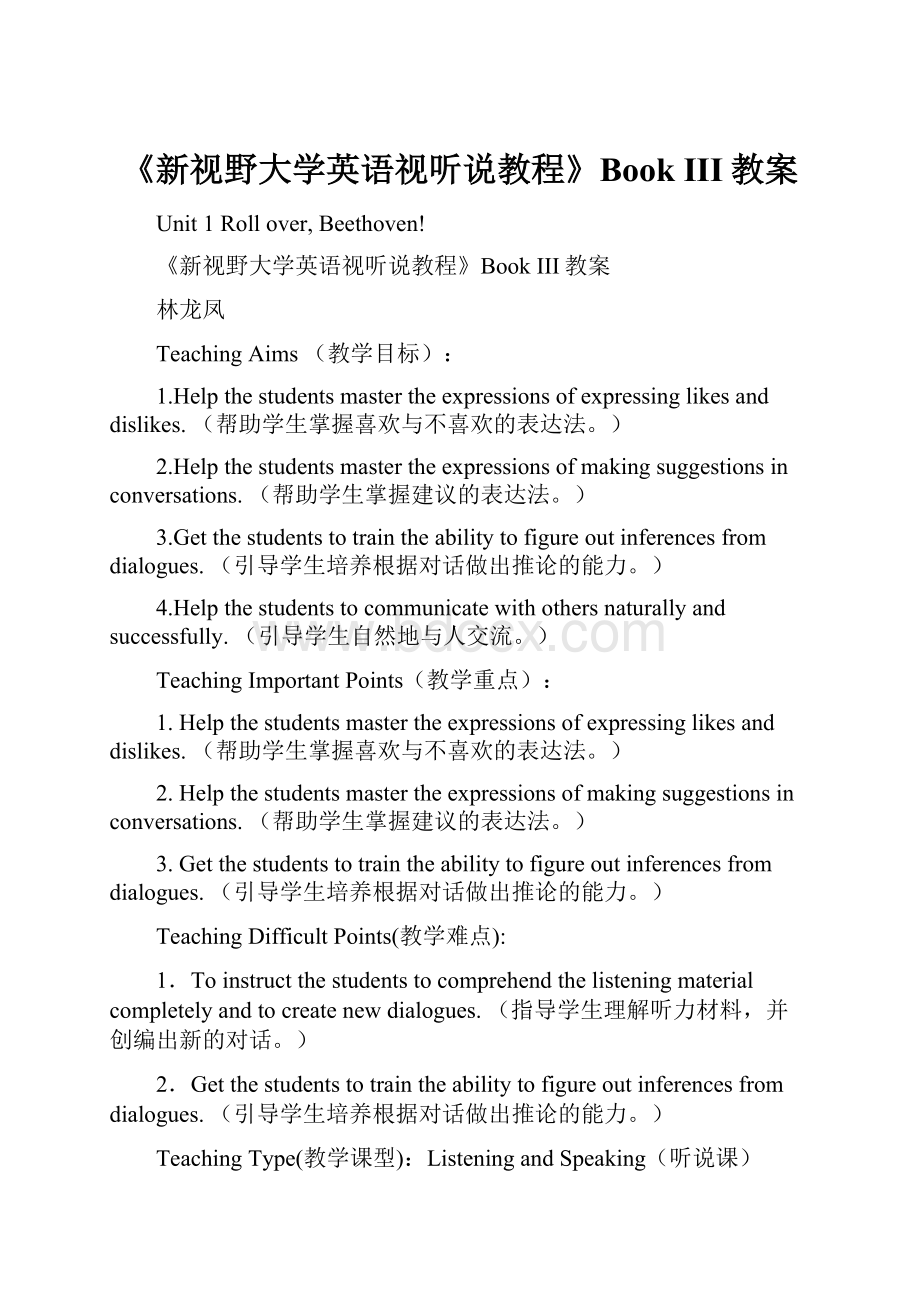《新视野大学英语视听说教程》Book III教案.docx
《《新视野大学英语视听说教程》Book III教案.docx》由会员分享,可在线阅读,更多相关《《新视野大学英语视听说教程》Book III教案.docx(13页珍藏版)》请在冰豆网上搜索。

《新视野大学英语视听说教程》BookIII教案
Unit1Rollover,Beethoven!
《新视野大学英语视听说教程》BookIII教案
林龙凤
TeachingAims(教学目标):
1.Helpthestudentsmastertheexpressionsofexpressinglikesanddislikes.(帮助学生掌握喜欢与不喜欢的表达法。
)
2.Helpthestudentsmastertheexpressionsofmakingsuggestionsinconversations.(帮助学生掌握建议的表达法。
)
3.Getthestudentstotraintheabilitytofigureoutinferencesfromdialogues.(引导学生培养根据对话做出推论的能力。
)
4.Helpthestudentstocommunicatewithothersnaturallyandsuccessfully.(引导学生自然地与人交流。
)
TeachingImportantPoints(教学重点):
1.Helpthestudentsmastertheexpressionsofexpressinglikesanddislikes.(帮助学生掌握喜欢与不喜欢的表达法。
)
2.Helpthestudentsmastertheexpressionsofmakingsuggestionsinconversations.(帮助学生掌握建议的表达法。
)
3.Getthestudentstotraintheabilitytofigureoutinferencesfromdialogues.(引导学生培养根据对话做出推论的能力。
)
TeachingDifficultPoints(教学难点):
1.Toinstructthestudentstocomprehendthelisteningmaterialcompletelyandtocreatenewdialogues.(指导学生理解听力材料,并创编出新的对话。
)
2.Getthestudentstotraintheabilitytofigureoutinferencesfromdialogues.(引导学生培养根据对话做出推论的能力。
)
TeachingType(教学课型):
ListeningandSpeaking(听说课)
TeachingTime(教学课时):
6periods
TheAnalysisoftheTeachingMaterial(教材处理):
1.Torearrangetheorderoflisteningexerciseandspeakingexercise,withpartofeachinoneperiod.
(重新调整课文听力练习和口语练习的顺序,使得每节课都有一些听力和口语练习。
)
2.ToprovidevideosofCNNnewsabouthowfansofBEATLEScelebratethegroup’sanniversary.(提供一段CNN新闻关于歌迷庆祝Beatles组团周年庆的视频材料。
)
3.Iftimeislimited,leavethepart
forthestudentstofinishbythemselves.(如果时间有限,就把第六部分的扩展练习留给学生自主学习。
TeachingApproaches(教学方式):
Discussion,listeningandspeakingpractice(讨论、听说);Task-basedteachingapproach(任务型教学方法);Interactiveteachingmethod(互动型教学方法)
TeachingProcedure(教学过程):
StepIGreetings
StepIIPresentation
I.Lead-in
1.Instructthestudentstoasktheirpartnersthefollowingfourquestionsandtrytoremembertheiranswers.Tgoesaroundtheclassroomtoofferhelpifnecessary.
⏹Whatkindofmusicdomostpeopleprefer,sloworfastmusic?
Canyouguesswhy?
⏹Whatkindofmusicdoyouprefer,classicalmusicorpopmusic?
⏹Doyouthinkmusiccanaffectpeople’slives,forexample,tocalmpeople,tocheerthemup,ortoincreaseefficiency?
⏹DoyoulikesingingKaraoke?
Why?
2.Severalminuteslater,invitesomestudentstotellthewholeclasswhattheirpartners’answersaretoaparticularquestion.
II.ListeningSkills:
listeningforinferences
1.Warming-up
AsktheSstothinkoverwhat‘inference’meansandexplainitforthelisteningpractice.
Forreference:
推理,结论conclusion;connotative;consequence;logic;speculation;suspicion;theory;
thereasoninginvolvedindrawingaconclusionormakingalogicaljudgmentonthebasisofcircumstantialevidenceandpriorconclusionsratherthanonthebasisofdirectobservation
n.推论,推断[U]
Hehasn'twrittentousforages,andmyinferenceisthathiseyesightmusthavegottenworse.他许久没来信了,我想他的视力一定变得更糟了。
n.推断的结果;(逻辑上的)结论[C]
Whatinferencescanwedrawfromthesefacts?
从这些事实中我们可以推出什么结论?
2.Listeningpractice
1)Playthe5recordingsonebyonefortwiceandaskthestudentstomakethebestchoices.
3)Asksomestudentstochecktheanswer.
III.ListeningIn
1.Task1:
Encore
1)ExplainthewordsinWordTipstogetthestudentspreparedforthelistening.Andaskthestudentstogothroughthestatementsandchoicesfirst.
•encore:
加演awordthattheaudienceshoutsattheendofaperformancewhentheywanttheperformertodomore
2)Playtherecordingtwiceforthestudentstofinishtheexercise.Andthenchecktheanswers.
2.Task2:
Livinginacampus
1)ExplainthewordsinWordTipstogetthestudentspreparedforthelistening.Askthestudentstogothroughtheuncompletedstatementsfirst.
•anorexia:
厌食aseriousillnessthatmakesyouwanttostopeatingandthatmainlyaffectsyoungwomen
•starve:
饥饿,饿死sufferordiebecausethereisnotenoughfoodtoeat
2)Explaintheculturetipabout‘theCarpenters’:
Theywerea1970slightpopduo,consistingKarenCarpenterandherbrotherRichard.Bothsang,andRichardplayedthepiano.Karenalsoplayedthedrums.TheirmusicalpartnershipcametoanendwithKaren’sdeathfromanorexiaat32.TheCarpentershavewonnumerousmusicalawardsovertheyears.Severaloftheirsongshavebecomeclassics.Forinstance,“ClosetoYou”isfrequentlysunginkaraokebars,and“We’veOnlyJustBegun”issungatweddingsorweddingreceptions,andthesongmentionedinthisdialogueis“YesterdayOnceMore”,whichhasbecomefamiliartoyou.Playthesong“YesterdayOnceMore”.
3)Playtherecordingtwiceforthestudentstofinishtheexercise.Andthenchecktheanswers.
4)Playtherecordingofthesong“Singasong”twiceforthestudentstofillintheblankswiththemissingwords.Andthenchecktheanswers.
Task3:
Mozart
1)ExplainthewordsinWordTipstogetthestudentspreparedforthelistening.Askthestudentstogothroughthequestionsfirst.PlayMozart’sSymphony.
•Mozart:
莫扎特(奥地利作曲家,维也纳古典乐派主要代表)anAustraliancomposerconsideredamongthegreatestandmostprolificcomposersinhistory
•Vienna:
维也纳(奥地利首都)thecapitalandlargestcityofAustria
•Salzburg:
萨尔斯堡(奥地利城市)acityofwest-centralAustria
•harpsichord:
大键琴alargemusicalinstrumentwitharowofkeysthatcanpullthestrings
•compose:
作曲writemusic
•symphony:
交响乐alongpieceofmusicforanorchestra
•Milan:
米兰(意大利北部城市)acityofnorthernItaly
•conductor:
(乐队的)指挥onewhodirectsanorchestraorothersuchgroup
•orchestra:
管弦乐队alargegroupofmusicianswhoplaytogetheronvariousinstruments
2)Playtherecordingonceforthestudentstoanswerthequestions,askingthemtonotedownwordsandphrasesoftimewhilelistening.Andthenchecktheanswers.
3)PlaythepassageagainandasktheSstocompletethetablewiththeinformationtheyhear(thenumbers).
4)DesignmorenumbersandreadthemoutforSstowritedown,andthenaskthemtosayoutthenumbersquickly,helpingSsfurtherunderstandEnglishnumbers,especiallylargernumbers.
Forreference:
(Years)1875;1329;1968;2003;1955;1491;1673;1746;1138;1973
(Numbersofpeople)morethan630;fewerthan2,500;over1,940;exactly2,398;approximately30,000
IV:
SpeakingOut:
Expressinglikesanddislikes;Makingsuggestions
1.Warming-up
1)Askthestudentstodiscussthefollowingquestionstoleadin.Teachergoesaroundtheclassroomtogivehelpifnecessary.
•Haveyoueverlistenedtoanytypeofmusic?
•Whichtypeofmusicisyourfavorite?
•Areyoufamiliarwithsaxophone,violinandguitar?
2)Asksomestudentstosharetheiropinionswiththewholeclass.
3)Explainthedifferentfeaturesbetweenmusicplayedbysaxophone,violinandguitar.
Forreference:
Saxophone
Jazz
Oftenslow-moving,emotional,sometimessad,etc.
Violin
Classicalmusic
Graceful,elegant,etc.
Guitar
Rock
Exciting,lively,etc.
2.Model1:
Doyoulikejazz?
1)Askthestudentstolistentothemodeldialogandpayattentiontothefirstphraseorsentenceineachboxofusefulexpressions,tryingtocompletethedialogue.Andthenchecktheanswers.
2)PlaythedialogthesecondtimeforSstorepeatitonesentenceatatime,makesurethestudentsunderstandthemeaningofthedialogueandthengivethemseveralminutestoreadthedialoguewiththeirpartners.
3)Explainthesituationof“NowYourTurn”andaskthestudentstofinishthedialoguewiththegivenphrases—“Voteforyourfavoritemusictypesandgiveyourreasons.”AskSstonotedowntheirpartner’sanswersandinvitesometoreporttheresultstotheclass.
•Pop
•Classical
•Folk
•Rock
•Country
•Jazz
•Blues
•Rap
•Opera
•HeavyMetal
•Dance
Debate
Name
Favoritemusic
Reasons
Classicalmusic
Requiringcloseattention
Popmusic
Easy,simplethemes,clearrhythm
Instrumentalmusic
Awiderangeofsounds,varityped.
Vocalmusic
Closertohumanfeelingorlife,etc.
4)Explainthesituation2of“NowYourTurn”andaskthestudentstocreateadialogueaccordingtothemodel—“Askyourpartnerwhathisorherfavoritemusictypesareandwhy,usingexpressionsintheboxeswhennecessary.”Thenasksomepairsofthemtorole-playtheirdialogue.
Usefulexpressionsforthedialog.
⏹Doyoulikejazz?
Whatdoyouthinkofjazz?
Howdoyoulike…?
⏹No,notmuch.
No,they’re/it’snotforme.
⏹I’mcrazyabout…
I’marealfanof…
⏹…Whatkindofmusicdoyoulike?
Areyouaheavymetalfan?
⏹Whatgroupdoyoulikebest?
Who’syourfavoritegroup/singer?
⏹Whataboutyou?
Whatdoyouthinkaboutthem?
⏹Theymakemystomachturn.
No,Icanhardlybearthem.
Sampledialog.
A:
Doyoulikeclassicalmusic?
B:
No,Idon’tlikeitatall.
A:
Whattypeofmusicdoyoulike?
B:
I’marealfanofpopsongs.
A:
Who’syourfavoritesingerorgroup?
B:
JayChou.Whatdoyouthinkabouthim?
A;Icanhardlybearpopsongs.Theyareallnoisetome.
3.Model2:
Doyoulikepunkrock?
1)Askthestudentstolistentothemodeldialogandpayattentiontothefirstphraseorsentenceineachboxofusefulexpressions,tryingtocompletethedialogue.Andthenchecktheanswers.
2)PlaythedialogthesecondtimeforSstorepeatitonesentenceatatime,makesurethestudentsunderstandthemeaningofthedialogueandthengivethemseveralminutestoreadthedialoguewiththeirpartners,andthenrole-playitinpairs.
3)Explainthesituationof“NowYourTurn”andaskthestudentstofinishthedialogue—“ChooseAandBcreateadialogwithyourpartner,usingexpressionsintheboxeswhennecessary.”WalkaroundtheclassroomwhileSsaretalking,andprovidenecessaryhelpwhenSsarehavingdifficulties,theninvitesomepairstoreporttheresultstothe